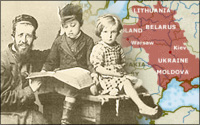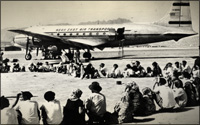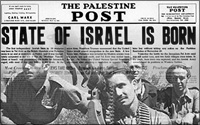 The early 1800s marked the beginning of a significant change for Jewish life in Eastern Europe. The change took place in many different spheres and on many levels.
The early 1800s marked the beginning of a significant change for Jewish life in Eastern Europe. The change took place in many different spheres and on many levels.
Population Explosion
The first was simply demographic: the Jewish population exploded during the 19th century. It is estimated that at the time of the Napoleonic Wars (i.e. the beginning of the 1800s) there were about 2.25 million Jews in the world. By 1880, that figure had reached 7.5 million. By 1900 it approached 9 million!
Many reasons are given for this population explosion. One is that it is not so much that the Jewish rate of birth increased as that the Jewish rate of death decreased, especially in the area of infant mortality.
Jews also married younger. The average age of marriage in Eastern Europe was estimated to be between 14 and 16. These young marriages helped increase the number of families and of children being born.
Urbanization
The second factor was the coming of the Industrial Revolution to Eastern Europe and the urbanization of its population. The Jews had lived in small, isolated communities—villages, farms, rural areas—as an agricultural-based people who lived among the peasants of Russia and Poland. The city of Warsaw had a very negligible Jewish population in the late 1700s. By 1850 it had 125,000 Jews, and by the time of the Second World War, it had a Jewish population 350,000.
The Jews came to the cities for various reasons. But they came for the same reason that urbanization was popular throughout the world. The cities meant an opportunity to get ahead. It meant a job. It meant getting off the farm.
During the 19th century therefore the Jewish people changed from a rural people to an urbanized one. And since the Jews, for whatever reason, had less attachment to the rural society, they urbanized much more quickly than their non-Jewish neighbors. They found the opportunities a grand challenge for their talents and their lifestyle.
Jews on the Move
A third matter that occurred then, in the beginning of the 19th century, was the complete mass emigration of Jews from one place to another. The Jews began to move.
They began to move within Russia, Poland and the Austro-Hungarian Empire. There was a shift in population of the Jews in Germany, from the eastern part close to the Austro-Hungarian border into Poland. Eastern European Jews began to move to southern Russia and the Ukraine. The large settlements of the Jews in northern Poland and northern Lithuania began to move south, as far as the Black Sea at the port of Odessa. There was a large Jewish migration from Galicia and from southern Poland to Romania and Hungary, so that the Jewish population increased tenfold there.
The coming of the Chassidic Movement to those areas of Europe where it had not existed before was part of this mass emigration. Beginning in the 1840s there was a trickle of emigration to the United States, but by the time of the American Civil War there were already 50,000 Jews in New York. Even though the basis of Jewish life there country was founded upon German Jews, who came first, Eastern European Jews began to come almost immediately thereafter. Then the great waves of migration in the 1880s until the First World War, and after it, brought millions of Jews to the shores of the United States.
Jews moved to England in great numbers, particularly Lithuanian Jews. A great number of Lithuanian Jews moved to such exotic places as South Africa, where in the Boer Republic that was established in the 1850s and 1860s there was already strong and with significant Jewish representation. At the time of the Boer War, at the end of the 19th century, there were almost 75,000 Jews in South Africa.
Jews moved to France. By 1850, there were 25,000 Eastern European Jews in Paris. Jews moved, for the first time, to Vienna, Budapest and Berlin. These cities now had sizeable Jewish populations.
All of this – the movement, the population explosion, the urbanization and the Industrial Revolution, the springing up of factories and different types of labor — served to unhinge the Jewish population. It brought an element of chaos into Jewish life. The old was going, never to come back again. The new was frightening, different, unpredictable, and the Jewish world was being thrust into it not only without preparation but without protection, with nothing to ease their way.
The Evil Decrees
The Jews were loyal to Russia during the Napoleonic War. This loyalty was rewarded by a series of decrees which, in the history of the Jewish people, are arguably the single worst series of decrees Jews have ever undergone. It would begin with Czar Alexander in the early 1820s and continue with his son Nicholas and then by Alexander III. Their intent was the utter destruction of the Jewish people.
It is rumored that the Czar’s minister said that the Jewish program of the Russian government was “one-third extermination, one-third emigration, and one-third assimilation (or conversion).” It is not overstating it that the elimination of the Jewish people in Russia was one of the goals of the Romanovs. It is interesting to see how that attitude was inherited by the revolution that overthrew the Romanovs, the Communist Revolution. The decrees were different but their purpose was the same.
The Pale of Settlement
The first main decree, which was put to effect in 1825, was establishment of the Pale of Settlement. This was an area within Russia where Jews were allowed to live. No Jews were allowed outside the Pale of Settlement. Within the Pale, Jews were not allowed to live in certain cities.
The Pale of Settlement decree, in effect, prevented any chance for Jews to advance economically. It was the ghetto on a grand scale. Jews were prevented from living anywhere within about 35 miles of the Russian border, which was heavily populated by Jews. The Russians openly said that the Jews were a risk and therefore they could not live close to the border. That meant that about 100,000 Jews were uprooted and forced to become refugees.
The Czar also forbade the Jews from living in any of the main cities of Russia. For instance, Jews were driven out of Kiev. They lived in all the small towns around it. The strong Jewish centers of population were overrun by penniless, itinerant Jews. All of this was meant to make certain that the Jews would not be able to adjust.
The Cantonist Decrees
In 1827, Czar Nicholas signed into law, “The Decree of the Cantonists.” From the beginning of the 1700s until the 1820s, Jews technically were liable for service in the Russian army. However, a Jew could legally buy his way out. If he paid a certain amount of money the conscription would be waived.
As part of the Czar’s program to break the Jewish people and force them to convert, and to help exterminate some of them and send a message to the rest that they had no future in Russia, the Czar passed a decree that no longer would it be acceptable to pay money to be exempted from the army, and that all the Jewish communities had to fulfill their quota.
The rate of suicide among the Jewish children who were taken was almost 60%, because they would not convert. From the moment they were taken away, they were forced to attend Russian Orthodox services. Many were forcibly baptized.
These children were taken into very rough conditions, to freezing cold places with poor sanitation. Not every 8-year-old child can march 10 or 12 miles every day. Out of those children who went into the army, very few came back. And out of those who did come back, very few of them came back as Jews.
The decree was unspeakably cruel. And it stayed in effect for almost 30 years. It was enforced more rigidly at some times and more leniently at others, but it was always there.
Good, Old Anti-Semitism
In 1840, Czar Nicholas produced the Mein Kampf of the Romanovs. He said exactly that the reason Jews cannot be assimilated into Russian society, and are not entitled to any of the Russian privileges, was because of their “terrible religion.”
Nicholas said that the problem with the Jews is that they believed in the “cursed book,” the Talmud. In Europe, there was an expression, “a Shas Jew” (Shas is a Hebrew acronym standing for the Six Orders of the Mishnah/Talmud). A Jew who knew the Talmud knew how to be a Jew. That is one of the reasons that even today in any sort of intensive Jewish education the emphasis is on Talmudic studies, even though the boy is not going to be a rabbi and may not even become a scholar. That has nothing to do with it. If he has studied Talmud for a number of years, then he has a chance to understand what it is to be a Jew.
The Czar also said that the problem with the Jews was that they thought of themselves as being in exile, because they were removed from Palestine, and therefore they wait daily for a Messiah to come and bring them there. All of these things were incompatible with Russian society and Russian patriotism.
He therefore appointed a commission called the Bureau of Jewish Affairs, whose purpose was to destroy the Jewish people. Part of the program was the establishment of schools, supported by the Russian government, that would teach Judaism — but not in the spirit of the Talmud. They would teach the Czar’s brand of Judaism.
They also would disband all the Jewish religious councils, and force the rabbis to take competency tests. These tests covered speaking, reading and writing in the Russian language, knowledge of Russian history and so on. Almost no rabbi in Russia could pass, or was even interested in passing, these tests.
The first half of the 19th century in Russia was a terrifying time for Jews. They were constantly targeted by the authorities, who placed upon them a series of terrible decrees whose impact lasted well into the latter half of the century and beyond. The sum total of these decrees would ultimately unleash various new and destabilizing Jewish movements in Eastern Europe, which in turn would spawn other Jewish movements to counteract them. The aftershocks of all these movements and events were so powerful that their repercussions can still be felt reverberating in the Jewish world today.











